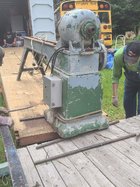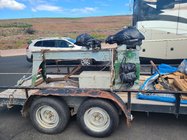I have recently purchases a 1944 Oliver 25-C lathe io the Olympic Pinensula and brought it home to Missoula, MT. I have yet to get it off the trailer, I plan to have the electrics checked out first. It seems to work fine. Are there others out there using this rig who could share stories with me? This is my first post.
-
April 2025 Turning Challenge: Turn an Egg! (click here for details) -
Congratulations to Kelly Shaw winner of the March 2025 Turning Challenge (click here for details) -
Congratulations to Ellen Starr for "Lotus Temple" being selected as Turning of the Week for 21 April, 2025 (click here for details) -
Welcome new registering member. Your username must be your real First and Last name (for example: John Doe). "Screen names" and "handles" are not allowed and your registration will be deleted if you don't use your real name. Also, do not use all caps nor all lower case.
You are using an out of date browser. It may not display this or other websites correctly.
You should upgrade or use an alternative browser.
You should upgrade or use an alternative browser.
Big Oliver
- Thread starter John Parker
- Start date
As Crocodile Dundee might have said, “That’s not a lathe. THIS is a lathe!”
Tom Gall
TOTW Team
That lathe is as old as me. I hope it works better than I do !!! 
I see your measly little machine and raise by one digit Oliver 26c
There are a few posts on the 25C at owwm.org
There are a few posts on the 25C at owwm.org
That's a pattern makers lathe. Nice machines. I wonder if that's the same one that was for sale on CL about a year ago.
I have recently purchases a 1944 Oliver 25-C lathe
I can see that your purchase included a tripod for outboard turning. Sturdy ones are are a bit hard to come by, so that's a nice extra, and will be invaluable if you ever need to do some outboard turning of larger diameter faceplate work.
That's a lot of iron! I turned on a 1953 Oliver 159 for 15 years, basically a school lathe from back when they were serious about teaching turning in schools. Mine was no where near as heavy and had a 14"swing but had a 60" bed. They are very heavy duty well built machines from the industrial era. If yours still has the 3 phase motor it will be a good candidate for converting to VFD. I don't know how to do it but a good electrician will.
I'm also impressed with your method of unloading it from the trailer. That goes back to the pyramids, doesn't it?
I'm also impressed with your method of unloading it from the trailer. That goes back to the pyramids, doesn't it?
I'm pretty sure that this Oliver was the first lathe I ever saw back when I was in high school (I can't swear to the model). It was used in the woodshop to mostly turn porch posts. The turning tools used on the lathe wouldn't even be recognized today. No eye protection, screws in the end of the timber to mount on the lathe, leather gloves were mandatory and it took 2 stout men to mount the timber. Also, oddly enough the builders/carpenters didn't want to hear about the prospects of a 2 piece post...they only wanted one piece posts for some reason. Ah...the good old days.
Hi John, nice score. That looks like it has the 4 speed motor head, basically four motors in one and there is a big selector switch to give you the four different RPMs. They are strictly 3-phase, so you'll need that or a phase converter to run it. The downside for these for turning bowls is the lowest speed is kind of fast. But, you may make it up with overall mass. As others have mentioned, a VFD might be a handy upgrade for speed control. In the past, VFD's were not recommended for antique motors as the insulation on the old motors might be compromised by transient voltage spikes from the VFD. Newer and better VFD's have minimized the voltage spikes and they can usually be safely put on old motors. You might also find the pattern makers carriage clumsy compared to a conventional woodturning lathe banjo, but you can probably retrofit an existing banjo if you wish.
The downside for these for turning bowls is the lowest speed is kind of fast. But, you may make it up with overall mass.
That's an interesting observation. My General definitely behaved better when weighted and bolted down, and having a really massive lathe should dampen out vibrations considerably. What is the lowest speed? And what does that beast weigh?
Looking at the pictures again, I see a new electrical box on the back, so perhaps my comments about the motor speeds are moot and maybe a VFD has already been added. I think the four speeds for the motor head were aproximately 600, 900,1200,and 1800. Mr. Parker will have to chime in and give us all the up to date details.
One of those Oliver machines back around that time frame used a DC motor and controller, they had an A, B, C and D series, not sure which one it was.
Nice little pen lathe you got there 


